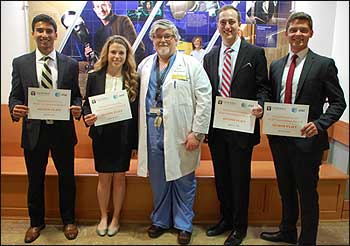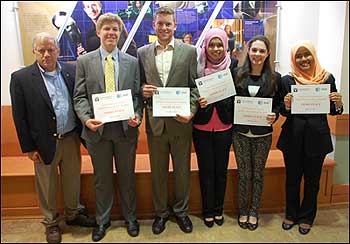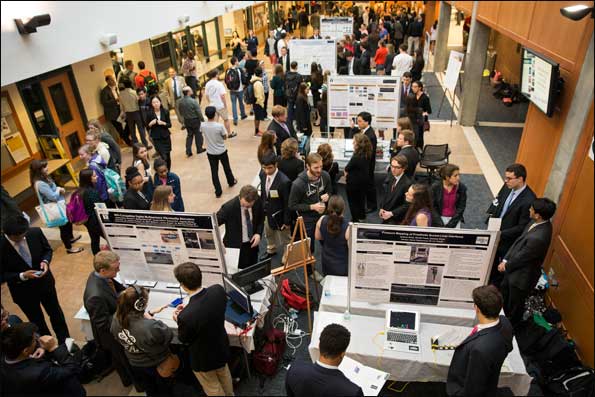
News from Design Day: More awards, more space for projects, a move to Vanderbilt’s Student Life Center in 2016, and in 2017 to the university’s new Engineering and Science Building, now under construction.

AT&T recognized three student design teams this year – first, second and third-place winners of its Innovation Award. In 2014, the company presented its first-time honor to one team and acknowledged two runners up. Pleased with the quality and breadth of student design, this year AT&T added two more awards.
A buzzing crowd toured the first floor of Featheringill Hall April 20 to see more than 60 innovative and entertaining engineering design projects created by teams of seniors who have devoted the better part of two semesters to solving design problems.
The use of two additional spaces – a classroom and a large teaching laboratory – allowed the event to be contained on one floor, and for less crowding of the project displays.
“A better layout with more space allotted for easier access to everything – from a rocket to microdevices and prototypes of everything in between – made it much easier to appreciate student design achievements this year,” said Associate Dean Cynthia Paschal, who serves as senior design coordinator.
Teams started setting up projects shortly after noon in order to accommodate project judges and media arriving at 3 p.m., an hour before the official opening of Design Day.
“It was noticeable that the crowd lingered much longer this year,” Paschal said. “We had almost a full house at 3, and we usually see the crowd thin toward the 6 p.m. close but that didn’t happen this year.”
“Student Life Center staff attended Design Day to get a better understanding of the scope of the event since it will move there next year,” Paschal said. “Of course, we’re excited about the change of venue to the ESB the following year.”
The AT&T Innovation award winners are:
- First Place, Translational Imaging Using Telemedical Modalities for 3D Printed Medical Devices. Team members are Nathaniel Braman, Attiyya Houston, Melena Mendive and Simeng Miao. The recognition includes a $2,o00 award.
- Second Place, Hysteroscopic Surgery Simulator (HSS). Team members are Aditya Karhade, J.R. Peacock, Madeline Tolish and Fletcher Young. $1,000 award.
- Third Place, JetStream Clean Hybrid Energy Scalable System (CHESS). Team members are Nicholas Augspurger, Hanum Hanafi, Alyssa Jaffe, Benjamin Asma Mohd Sidik and Sturgeon. $500 award.
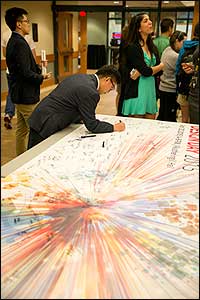
Using smartphone imaging and 3D printing, the winning team created castings to correct clubfoot, a congenital deformity in infants characterized by the inward twisting of a foot. Treatment requires a series of casts to reposition the foot, often requiring weekly visits to an orthopedist. Using a smartphone, parents are able to take photos of their child’s foot from key angles. An image processing app predicts and applies the next phase in correction to a 3D cast model. That model is sent to a 3D printer, which creates a customized cast.
“The team’s protocol reduces the technical skill requirement and empowers parents to take an active role in their child’s treatment,” said Matthew Walker III, associate professor of the practice of biomedical engineering and the team’s faculty adviser. “The students’ innovation led to a design that enhances benchmarks around efficacy and convenience.”
The second-place team designed a simulator for obstetric and gynecologic laparoscopic surgery using a 3D-printed uterus to create the surgical environment, with haptic feedback and quantitatively measured skills associated with various tasks for a trainee to perform. This design is a more affordable alternative to current HHS systems, and medical residents in the Department of Gynecology at Vanderbilt University Medical Center will test the design.
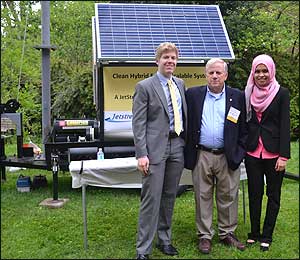
The third-place team produced a working prototype of a portable wind, solar and auxiliary gas generator energy system for JetStream Energy Systems. While competing companies currently offer wind and solar systems, Jetstream’s system has been programmed to optimize the use of its three components based on the surrounding environment.
“This prototype allows JetStream to share a feasible, innovative design with potential investors and begin the commercialization process,” said Mike Myers, adjunct assistant professor of civil engineering and computer science and the team’s faculty adviser.
“In the school’s design courses, students learn how to assess client needs, research existing designs, and apply both creativity and engineering concepts to produce design solutions, all while working in teams upholding professional, ethical, and business standards,” said Paschal. “The senior design experience and Design Day exposition are a culmination and celebration of their undergraduate education.”
The 2014-2015 design faculty are Bob Webster, Tom Withrow and Joel Barnett, mechanical engineering; Matthew Walker III, biomedical engineering; Russell Dunn, Scott Guelcher and Ken Debelak, chemical and biomolecular engineering; Sanjiv Gokhale, civil engineering; Ralph Bruce and Jules White, electrical engineering and computer science.
Contact:
Brenda Ellis, (615) 343-6314
Brenda.Ellis@Vanderbilt.edu
Twitter @VUEngineering
